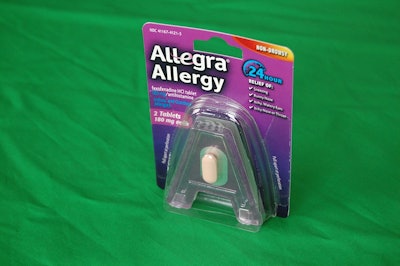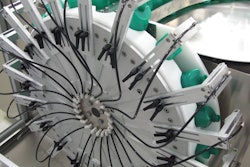For the first time, consumers can now purchase a trial pack of Allegra non-drowsy antihistamine allergy medication, a product that recently switched from prescription-only to over the counter. The trial pack was launched nationwide in October by Chattem, the Chattanooga, TN-based consumer health care division of Sanofi US, and will be available on store shelves nationwide by the end of the year.
The primary packaging is distinctive, particularly in that it is patterned (and shaped) after the Allegra “A” logo. Its color scheme stands out on the shelf, while the pack is easy to carry, simple to open—there’s no rigid plastic to cut through—and it’s resealable.
Chattem, Sanofi, and external resources were employed to differentiate the trial pack from competitive trial packs, which are often merchandised in a rigid plastic clamshell or blister shell sealed to a card. Chattem believes other merchandising options, which consist of rigid plastic thermoforms sealed to a card or full clamshells trapping one or more pieces, are typically hard for consumers to open. Once opened, the contents can spill out all over. They do not usually offer the advantage of a reusable grab-and-go package.
The Allegra trial pack is easy to open, provides tamper-evidence, and brings consumer-preferred grab-and-go convenience.
Patent applications have been filed for the new trial pack, which represents several “firsts” for Chattem/Sanofi U.S. and the Allegra brand. Among them:
• The “A” blister is the company’s first use of a non-square or rectangular-shaped blister card
• It’s the company’s first commercial use of new patient-preferred, child-resistant, push-through foil blister material
• The breakaway clamshell is the company’s first use of an internally designed breakaway clamshell with a tamper-evident and theft-deterrent design, which also functions as a reclosable, reusable “nomad” package
• It’s also the first time the company has used RPET in the clamshell
• The first use of a heat-seal merchandising card with rigid clamshell/display tray for Allegra OTC
• First company use of Sustainable Forestry Initiative (SFI)-certified paperboard and logo for the heat-seal card and display tray
The new packaging contains two 180-mg tablets, each in its own blister cavity, for a two-day supply. Shelf life is two years, with a suggested retail price of $3.99.
In the following interview, Healthcare Packaging talks with Nancy Limback, a Sanofi US package development group representative, about the new Allegra packaging.
Who was involved in the design and development of the packaging?
It was designed by the Industrial Development and Innovation team at Sanofi in St. Louis, working with a team including Chattem and Sanofi Industrial Affairs, St. Louis. The team began with 30 different packaging concepts before selecting on the current design. The development was a true team effort between internal and external vendor partners. For example, we worked closely with Witko Inc., a contract packager that also helped overcome challenges and meet the launch date. The blister packaging is done by Sanofi US’s St. Louis location.
Describe the packaging materials used in the trial pack?
The Allegra trial pack optimizes the use of several materials, including post-consumer/post-industrial content, RPET resin used in the clamshell cards, and trays made from paperboard certified by the Sustainable Forestry Initiative, and lightweight blister foil material.
Tell us a bit about Chattem.
Chattem is a Sanofi company, founded in 1879. Some of our more well-known consumer healthcare brands include Gold Bond, IcyHot, ACT, Cortizone, Unisom, and Selsun Blue. Sanofi acquired Chattem in 2010. They helped us really launch Allegra, which was a Sanofi product available via prescription only. They helped us introduce it over-the-counter in early 2011, after it was approved by the U.S. Food and Drug Administration for that purpose. There is a family of Allegra products now available over the counter for use by both adults and children two years of age and older, providing them relief of symptoms from indoor and outdoor allergies.
What must packaging do for the Allegra trial pack?
Well, first it must continue to add value for our end users. It is a new SKU for us and is the first time that we used a trial-package approach for Allegra OTC. As I said, it was a cross-functional team including Chattem St. Louis Industrial Affairs and Package Development, that started by defining user-centered and customer-centered design input and needs.
One requirement was grab-and-go or “nomad” convenience packaging that represents a very big advancement. We also wanted a trial-pack SKU that would grab attention, reinforce our brand image, and encourage new users to either switch from a competitive brand, or to attract someone who wants to try Allegra but doesn’t want to buy a larger number of tablets.
We considered a number of other technical design requirements, such as providing adequate shelf life, protecting the product throughout distribution, and meeting child-resistance and tamper-evident requirements. It also had to be flexible enough to stand on a shelf by itself or within a paperboard display tray, and yet be able to hang on a peg.
It had to provide users with the same shelf life and barrier properties as packs carrying greater quantities of Allegra. That’s part of the value-added customer proposition. At the same time, the packaging uses a new CR push-through blister backing that is preferred by end users over peel-push or tear-notch packaging options.
There are a lot of positives to this innovative package. It uses preprinted foil with a purple backing that provides attention-grabbing features. There was quite a list of design inputs that we defined at the beginning of the project that helped guide the development and successful end results.
Once you knew what you wanted from the packaging, how did you go about searching for vendors to supply the materials?
Initially, Package Development took all of those design inputs and came up with about 30 different approaches, including different primary packs, such as blisters and pouches, and various shapes and counts. We considered secondary packaging options such as paperboard, molded pulp, and both flexible and rigid plastics.
We presented these design inputs and packaging options to our team, which included considerable input from marketing. Then Package Development led vendor partners and worked with our overall project team to finalize package details. (Vendor details are considered proprietary.)
Overall, how many different package components are there for the Allegra trial pack?
While various aspects of the trial pack are proprietary and are subject to patent protection, as a general description, there’s a paperboard card with product name, information, and a $4 promotional coupon taped to the front. On the back are drug facts, uses, warnings, directions, and ingredients, a toll-free number for questions or comments, and UPC code. The card is made with Sustainable Forestry Initiative-approved board.
There’s a clear, hinged RPET clamshell-style blister that houses the two A-shaped samples. Each of the two uses a preprinted foil backing, with a clear laminate that’s heat-sealed to the blister card. The clamshell allows the user to open and reclose it so you can store it in your purse, backpack, briefcase, etc. All three of these components are A-shaped to reinforce the brand image and logos. The RPET clamshell neatly breaks away from the backing card. A die-cut tab near the top of the card enables retailers to display it on a peg, hang it on clip strips, or simply display the entire display tray, which holds six of these packs. The display tray is also made from SFI board.
When was this first sold?
It began going into distribution channels in October and will hit different retail outlets at different times. This package also offered us new distribution arenas for Allegra. We will be upfront in the stores by the cash registers in the large retail chains and drug chains. It will also be marketed in the travel section and will afford Allegra new venues through convenience stores, airport gift shops, hotel gift shops, etc.
Are there any other details you’d like to add?
This package was a winner of one of Sanofi’s Global Innovation Awards. The team is excited to bring innovative packaging to Allegra users.


























